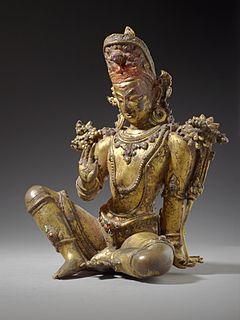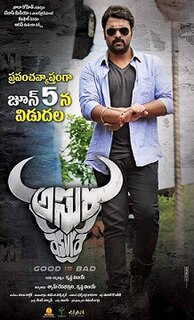
The following outline is provided as an overview of and topical guide to Hinduism:

Asuras are a class of beings or power-seeking clans related to the more benevolent Devas in Hinduism.

In Hinduism, Diti is the Mother of Asuras and supporter of Asuric attributes. She is mother of both the Marutas and the Asuras (Daityas) with the sage Kashyapa.

Vritra is a Vedic serpent, dragon or demon in Hinduism, the personification of drought and adversary of Indra. Vritra is identified as an Asura. Vritra was also known in the Vedas as Ahi. He appears as a dragon blocking the course of the rivers and is heroically slain by Indra.

A vajra is a ritual weapon symbolizing the properties of a diamond (indestructibility) and a thunderbolt and is the Sanskrit word having both meanings.

The Four Heavenly Kings are four Buddhist gods, each of whom is believed to watch over one cardinal direction of the world. In Chinese mythology, they are known collectively as the "Fēng Tiáo Yǔ Shùn" or "Sì Dà Tiānwáng". In the ancient language Sanskrit, they are called the "Chaturmahārāja" (चतुर्महाराज) or "Chaturmahārājikādeva": "Four Great Heavenly Kings". The Hall of Four Heavenly Kings is a standard component of Chinese Buddhist temples.

Deva means "heavenly, divine, anything of excellence", and is also one of the terms for a deity in Hinduism. Deva is a masculine term; the feminine equivalent is Devi.

In Hindu mythology, Durvasa also known as Durvasas, was an legendary Rishi and the son of Anasuya and Atri. He was a great devotee of Lord Shiva and goddess Parvati. Known for his short temper, wherever he went, he was received with great reverence from humans and devas alike.

Ayya Vaikundar, also called Sriman Narayana Vaikundaswamy, is the tenth avatar or incarnation of Vishnu who worked for the upliftment of downtrodden people in the Kingdom of Travancore while in human form in the 19th century. He is central to the Hindu denomination of Ayyavazhi, as per the holy scripture, Akilathirattu.

Kacha was an ancient sage and the son of Brihaspati in Hindu mythology. The narrative of Kacha is mentioned in the Mahābhārata, the Matsya Purana and the Agni Purana. He was known for learning Mrityu Sanjivini Mantra but failed to bring many dead Devas back to life due to earning the wrath and curse of Shukracharya's daughter Devayani.
The following is a glossary of terms and concepts in Hinduism. The list consists of concepts that are derived from both Hinduism and Hindu tradition, which are expressed as words in Sanskrit as well as other languages of India.
The four stages of enlightenment in Early Buddhism and Theravada are four progressive stages culminating in full enlightenment as an Arahant.

An asura in Buddhism is a demigod or titan of the Kāmadhātu. They are described as having three heads with three faces each and either four or six arms.
Humans in Buddhism are the subjects of an extensive commentarial literature that examines the nature and qualities of a human life from the point of view of humans' ability to achieve enlightenment. In Buddhism, humans are just one type of sentient being, that is a being with a mindstream. In Sanskrit Manushya means an Animal with a mind. In Sanskrit the word Manusmriti associated with Manushya was used to describe knowledge through memory. The word Muun or Maan means mind. Mind is collection of past experience with an ability of memory or smriti. Mind is considered as an animal with a disease that departs a soul from its universal enlightened infinitesimal behavior to the finite miserable fearful behavior that fluctuates between the state of heaven and hell before it is extinguished back to its infinitesimal behavior.

In Hindu mythology, Nahusha was a king of the Aila dynasty and the 3,698,256th Indra (position). He was the son of Āyu, the eldest son of Pururavas, and Prabha, the daughter of Svarbhānu. Nahusha reigned from Pratishthana. He married Viraja, the daughter of the Pitrs. They had six or seven sons, according to different Puranas. His eldest son Yati became a muni (ascetic). He was succeeded by his second son Yayati. In another and more popular variation of his story, he is said to have married Ashokasundari, a goddess who the daughter of Shiva and Parvati and is said to have given birth to Yayati and a hundred daughters of Nahusha.

Asura is a genus of moths in the subfamily Arctiinae erected by Francis Walker in 1854.
In Hinduism, Ādityás, meaning "of Aditi", refers to the offspring of the goddess Aditi and her husband the sage Kashyapa. The name Ādityá, in the singular, is taken to refer to the sun god Surya.
Kavyamata — also called Usanas — is a minor character in Hinduism. She is described as a consort of wise Bhrigu, and the mother of Shukra, the god of the planet Venus and the preceptor of the Asuras or demons. She is the reason why god Vishnu was cursed to take Avatars on Earth.

Asura is a 2015 Telugu film directed by debutante Krishna Vijay. The film was produced by Shyam Devabhaktuni and Krishna Vijay jointly, and stars Nara Rohit and Priya Banerjee in the lead roles. This film received a positive reception and was declared a box office hit.
The Eight Legions are a group of Buddhist deities whose function is to protect the Dharma. These beings are common among the audience addressed by the Buddha in Mahāyāna sūtras, making appearances in such scriptures as the Lotus Sutra and the Golden Light Sutra.













